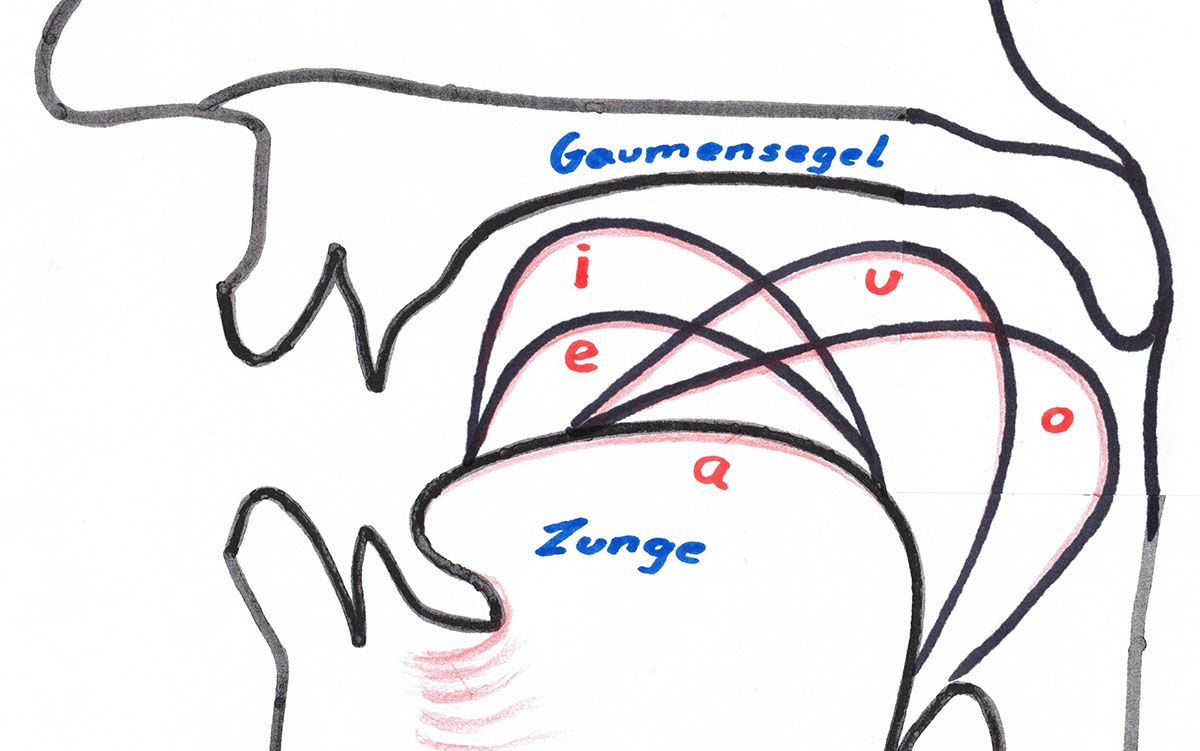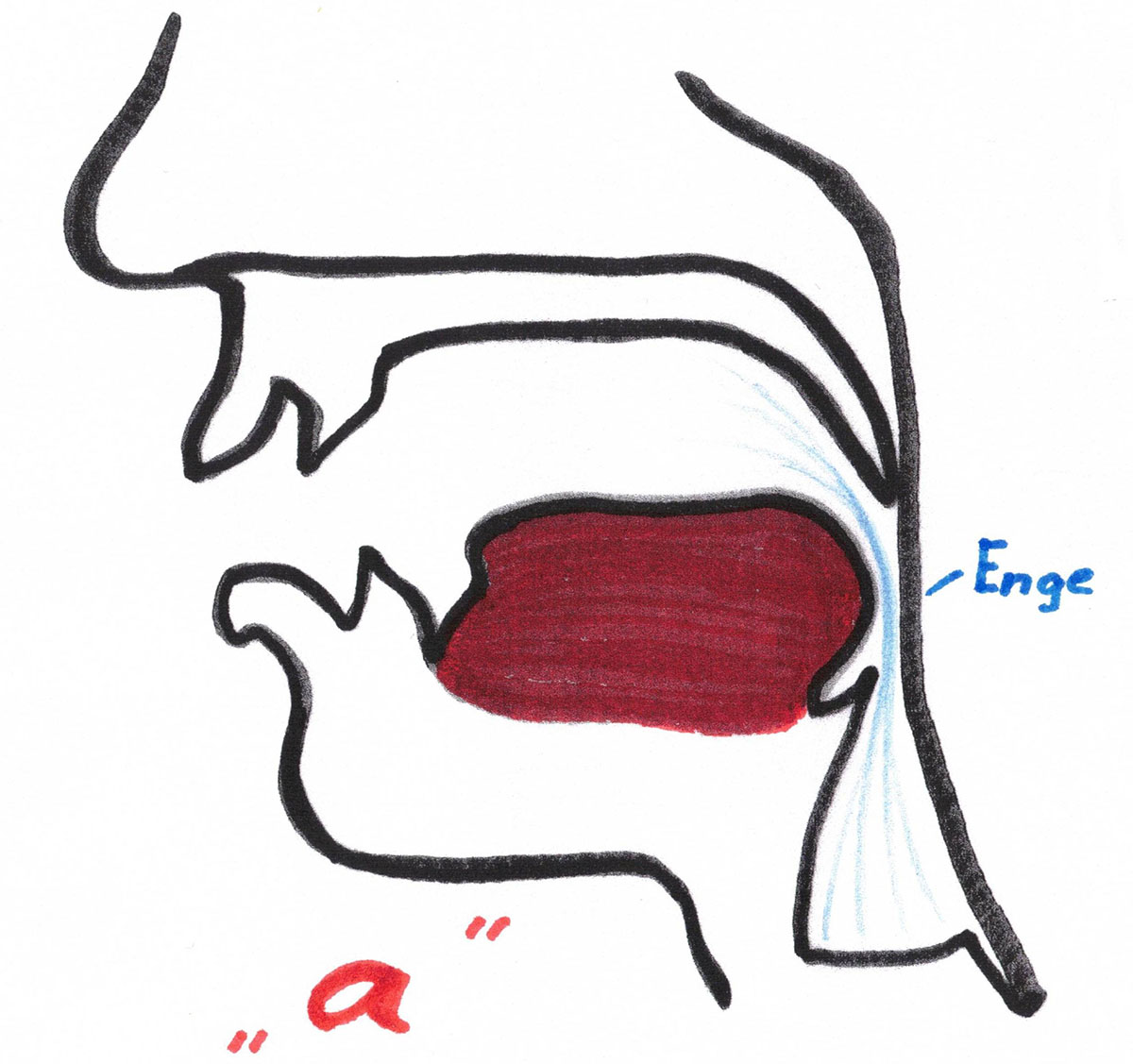Every held note is a sung vowel. Vowels and their sound are much more important when singing than when speaking. However, singing a vowel full of radiance is harder than expected for many singing beginners.
As singers, we are faced with the task of creating the best possible resonance or sound for each vowel. This blog article is about how we do that and what can help us.
If you could make the vocal cords vibrate without anything at all, their sound would be unimpressive. They would have a buzzing sound, similar to the quacking of a duck. But this humming contains the entire spectrum of sounds we need to speak and sing: It is rich in overtones.
Our vocal tract: how vowels are formed
Distinguishable vowels are only created by the space in which the vocal cords vibrate. This is the space above the larynx, up to the mouth and nose, anatomically called the "vocal tract". It filters and amplifies the sound of the vocal cords.
Whenever the overtones of the vocal cords come into a common vibration with the vocal tract, the sound is amplified: this is the "resonance" we want to have when singing. We can determine for ourselves in which overtone ranges this resonance is produced. These amplified overtone ranges are the vowels: A - E - I - O - U.
Tongue: finding the sound of the vowels
We form the vowels by changing the space of our mouth with the tongue, the soft palate, the lips and the jaw. The tongue is our main tool for creating vowels. Depending on where our tongue lifts in the space of our mouth, we produce different vowels.

Not all vowels you sing have the same radiance right away - your "A" or "O" may sound duller than an "I" or "E", which are formed further forward in the mouth. This could be because you pull your tongue back when you sing "A" or "O". This pushes the root of your tongue downwards and covers the sound space to the larynx. This reduces the vowel sound enormously. Here you can see it in the picture:

Therefore, make sure that the tip of your tongue is always gentle when singing the vowels. rests against your lower incisors - from "I" through "E" and "A" to the vowels "U" and "O" formed in the back of the mouth. If you sing in a very high register, you can bring your tongue even further forward over your lower incisors until the tip of your tongue touches your lower lip from the inside. This gives your tone more sound in the high register and gives yourself a freer feeling in the throat.
The drop in sound of the vowel "A" formed in the middle and the vowels "O" or "U" formed at the back tempts many singing beginners to become louder. But making up for a lack of sound with volume is not a good idea. Before you start, therefore, observe the following basic rule: Teeth apart! This applies to the open vowels "A" and "E" as well as to the more closed vowels "O", "U" and "I".
There must be room for at least one little finger for each vowel. Without the mouth opening a finger's width, the throat space will be tight and the sound will be muffled and cut off. In higher registers, you should open your mouth even wider.
Sing through all the vowels (with transition vowels) and consciously listen to their different sounds. The order from front to back is: "I" (like "hedgehog"), open "I" (like "lattice"), "E" (like "ivy"), "Ä" (like "hands"), "A" (like "maple"), open "O" (like "sun"), "O" (like "trousers"), open "U" (like "mother"), "U" (like "bleed").
Soft palate: resonance, nostril test and cheek lift
How full and resonant your vowels sound depends not only on your tongue. Your soft palate should also be involved, and more actively than you might think.
For fun, stand in front of a mirror, open your mouth wide and shine a torch inside: what you see at the top is your soft palate with the "uvula". This is your soft palate. In everyday life, you pull up your soft palate when you yawn. It is the movable part of your palate that is also involved in forming the Consonants "K" and "G" is involved.
With all vowels and umlauts except the "I" and the "E", we also have the possibility of additionally strengthening the resonance by raising our soft palate. If, on the other hand, your soft palate is relaxed and hanging down, the space to your nose is open. If you sing with an open nasal cavity, your notes will sound nasal.
This twang has nothing to do with the amplification of nasality called twang. The twang is a constriction in the laryngeal space that gives the sung sound an additional sharpness or nasality. Both the raised soft palate and the twang increase the carrying capacity of the sung vowels.
In rock and pop singing, also in jazz or musical theatre, we more often hear a tone quality with twang - as an effect, a means of expression, sometimes even as a preferred sound colouring. Even though this increases nasality, we should pull the soft palate upwards as far as possible. If we leave the soft palate hanging when we sing, the notes sound thinner, they are less resonant. Please also read our blog article on the Theme Twang
If you want to give your vowels more resonance and warmth, the motto is therefore: Sing your vowels in such a way that you can Lift your soft palate and closes the nasal cavity. In this way, you also open your mouth more, which makes the vowels sound full. Here you can see the difference:

Lifting the soft palate is essential to bring out the full sonority of the vowels when singing. Most of the time we do this by ourselves as soon as we sing vowels without paying attention. But if you want to be absolutely sure, then do the following during your vowel exercises. Nostril test. The test is a classic in popular singing technique. It's best to do it like this the first time:
- Sing a nasal vowel, like the French "Non". While holding the nasally opened vowel, close your nostrils with your thumb and index finger. Do this several times while holding the sound - squeeze nostrils, open, squeeze ...
The difference in sound you hear shows that your soft palate is hanging, your sound is going through the mouth and nose at the same time. - Then sing a non-nasal vowel, going from an "N" or "Ng" (as in "Sing") to an "I". As you transition into the vowel, the tip of your tongue should come back to rest on your lower incisors. While holding the vowel "I", close your nostrils again with your thumb and index finger.
If you do not hear any difference in the sound quality of your "I", then you can be sure: Your soft palate is up and has closed the access to the nasal cavity. Your "I" is not nasal, but can be heard with full resonance. If the sound changes, your nasal cavity is (fully or partially) open and your soft palate is hanging. - Repeat the test with all vowels, from "Ng-i" to "Ng-e", "Ng-a", "Ng-o" and "Ng-u". You should not hear any difference in sound when you flap your nostrils during the vowel.
Many singers have developed a distinct ability to create width in their oral cavity and vocal tract by actively lifting the soft palate. In addition, they pull it wide in the process. They go into a Smile that lifts the cheekswhile the lower part of the mouth remains relaxed. This creates additional space and contributes to the bright, radiant vocal sound we hear especially in pop and soul singing. Try it for yourself:
- With the open vowels, especially in the high register, it helps if you imagine that you are about to bite into a delicious, large apple while inhaling. This will cause your soft palate to rise and widen even before you make the sound - take this opportunity to remember that you adjust your vocal apparatus at the moment of inhalation. This happens during the short diaphragm impulse with which we draw air for the coming vocal phrase.
- We can also raise the soft palate with the vowels closed. Try yawning with your mouth closed - that's what it feels like. You can pull your soft palate up the furthest with the closed vowel "U".
Lips: round or wide?
To sing sonorous vowels, the tongue and soft palate must work together with the lips. When singing, we distinguish between open vowels such as "E", "Ä", "A" (which also include the open "Ö" as in "Können" and the open "O" as in "Sonne") and closed vowels such as the "I", "O", "U" (also the closed "Ö" as in "Lösen" and "Ü" as in "Güte").
For the back, closed vowels "O" and "U", we round our lips, turn them forward and thus expand the resonance space of the mouth and throat. This gives the vowels a warmer but also darker sound. In classical singing, this darker sound is further intensified by approaching the notes or pulling down the larynx. As can often be seen in classical singing, we can also transfer this rather vertical mouth opening to the other vowels, such as "I", "E" or "A".
In popular singing, we tend to avoid this darkness. Instead we go into the "Width tension"For the most brilliant, bright sound possible - especially with the open vowels - we smile or lift our cheeks slightly. In the case of text-heavy songs with a high tempo, the voice penetrates even better and the lyrics remain easily understandable.
Caution: Please do not open your mouth so wide that tension is created in the neck and throat area. Think of something pleasant, like biting into a big apple, and smile, with the soft palate raised and the cheeks slightly lifted, as described above. In this way, with a smiling face, you bring the radiant sound into your singing that you desire.






